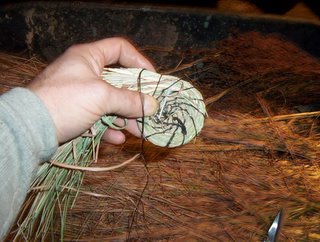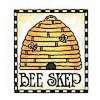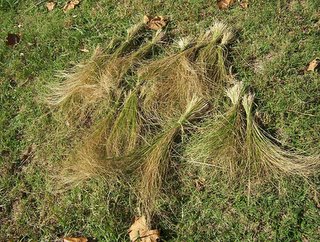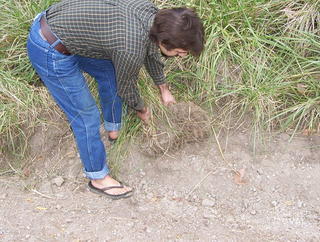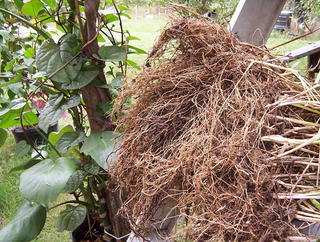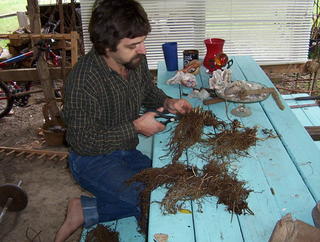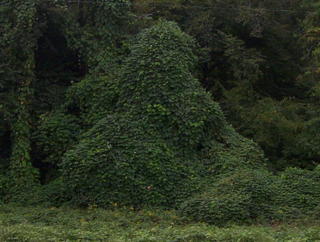 Harvesting:
Harvesting:Although kudzu can be harvested anytime of year, July through the first frost are the prime times to pick kudzu's long, tough runners. It's best to find a field with long runners on the ground, as it's quite difficult--and dangerous--to pull kudzu out of trees. After the summer solstice, the fast growing green kudzu vines begin to get fibrous, making them durable!
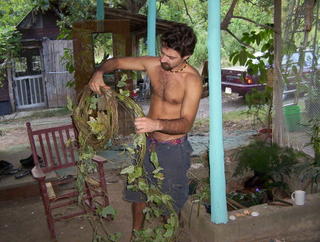
Kudzu, as well as most weaving material, needs to be dried thouroughly, then rehydrated
just enough before working with it. If green vines are weaved, the basket will be loose and not very durable. This being said, all of my early baskets were made out of green vines. If they loosened up, I'd just weave more vines into them. Also, some materials don't shrink as much as others, so it isn't as noticable--such as grapevine, which has minimal shrinkage. A new weaver, full of enthusiasim, doesn't really need to burden himself with weeks--months even--of prepwork before attempting to weave a basket! He might try weaving and decide it isn't for him. If you have the desire, just go pick some vines, and do it.
Kudzu vines can be weaved whole, green, or after drying and rehydrating, or they can be processed into finer fibers, which can be dyed. Store kudzu in loose coils (like wrapping a hose up on your arm), in a dry location. Sunlight helps change the green colored vines to a more pleasant brown.
If you'd like some guidance while experimenting with kudzu, here's how I prepare the fibers:At any point in this process, you can just coil the vines, dry them, and return to working with them later.By the time the vines are ready to weave, they will have been coiled and uncoiled several times.
Grade the kudzu according to size as you work. It's much easier to select a 'thin' vine from a pile of thin vines, than from a pile of all sizes jumbled together.
Go gather some vines. They are various shades of green, and some are gray. The greenest vines are the freshest growth. They grey vines are last years, or older. Pick any and all. I like to find vines the diameter of my pinky finger. Coil them into manageable loops. If you are going to completely dry these vines before you get back to working them, be sure to make your coils small enough to fit in your soak pot, whether a wash tub, bath tub, or stock pot. If the weather is nice, and you live in a rural location, you can soak your kudzu in a river, or lake, and weave while swimming/sunbathing.
Cleaning and sorting:It's easiest to work with kudzu soon after it has been harvested. Uncoil the kudzu you've gathered, remove the leaves and twigs, and separate vines according to thickness. Be sure to recoil the vines into coils smaller than the diameter of your stock pot! The thinnest, greenest vines, are fragile right after picking, and need to be handled without kinking them. They lose about 70% of their weight during drying. They are extremely brittle before mellowing, so be careful not to crunch them during dry storage or while rehydrating.
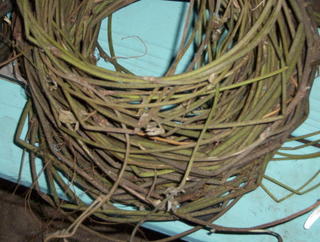
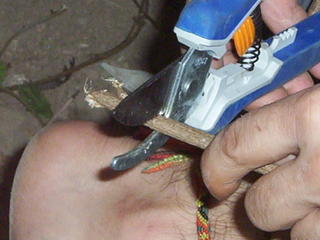 Splitting:
Splitting:The larger vines should be split. Clip the end off so you have a smooth surface to start splitting. Using a kitchen knife, start to split the vine in half
lengthwise, right through it's pithy center. Once you've split the vine, recoil it for storage.
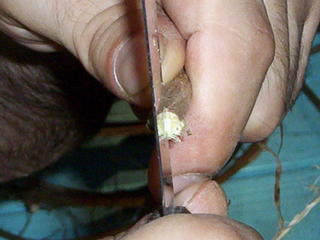
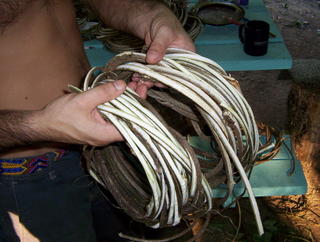
 Cooking:
Cooking:Carefully lower the kudzu into a stockpot of hot water. There is some debate about whether or not to boil the vines. I prefer to boil mine until they are good and soft, but I have been accused of over-cooking things before. If you are cooking dried vines, dip each end of the coil into the water before cramming the vines into the pot. This softens them a little, making them less likely break. Cook the kudzu until the pithy center changes from white to clear--it's much easier to scrape off. You might need to take it out of the water and test it. Different thicknesses may require different cooking times. You can use a variety of implements to scrape the pithy center out, such as this sea shell. A round-tipped knife also works. Generally, I prefer to scrape the pith while the bark is still on.
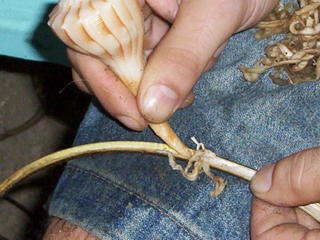 Peeling:
Peeling:Next peel off the bark. Uncoil a vine after it cools a bit. Using the index finger of one hand, hold the bark and vine apart. Pull on the bark with the other hand away from you. Use which ever hand feels natural. Be sure to save the bark in loose coils--it looks like dried emuskin when woven!
Recoil all of the kudzu.
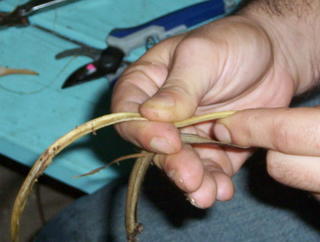
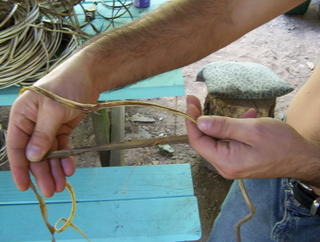 Refining the weavers:
Refining the weavers:Next, uncoil a piece of split, cooked, depithed, and peeled kudzu, and split it again
lengthwise with a pocket knife. Most of the pieces will have a split started. Just fullow the grain in the vine, and you'll be fine. Try to make the pices a consistent thickness. Coil them as you go.
The kudzu stockpile now consists of: thin green vines, split white fibers, bark, and whatever whole kudzu you've decided not to split. the kudzu is ready for weaving (or you
could dye the split vines).
